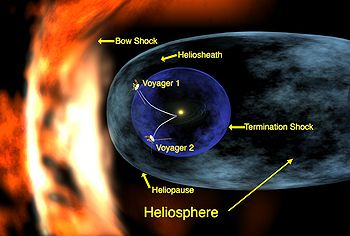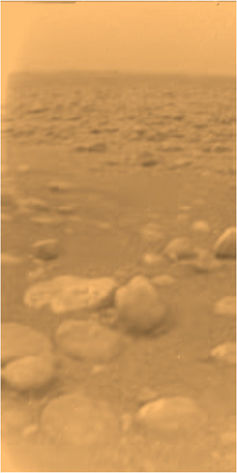Space probe
A space probe is a scientific space exploration mission in which a robotic spacecraft leaves the gravity well of Earth and approaches the Moon or enters interplanetary or interstellar space (see list of probes by operational status for a list of active probes); The space agencies of the USSR (now Russia and Ukraine), the United States, the European Union, Japan, India and China have in the aggregate launched probes to several planets and moons of the solar system as well as to a number of asteroids and comets.
Contents |
Interplanetary trajectories
Once a probe has left the vicinity of Earth, its trajectory will likely take it along an orbit around the Sun similar to the Earth's orbit. To reach another planet, the simplest method is to execute a maneuver. More complex techniques, such as gravitational slingshots, can be more efficient, though they may require the probe to spend more time in transit. A technique using very little propulsion, but possibly requiring a considerable amount of time, is to follow a trajectory on the Interplanetary Transport Network.[1]
Some notable probes
Mariner 9
Upon its arrival at Mars on November 13, 1971, Mariner 9 became the first space probe to go into orbit around another planet.
Rosetta
The Rosetta space probe is aiming to rendezvous with the comet 67P/Churyumov-Gerasimenko. It is scheduled to arrive at the comet in 2014.[2]
Spirit and Opportunity
The Mars Exploration Rovers, Spirit and Opportunity surface and geology, and searched for clues to past water activity on Mars. They were each launched in 2003 and landed in 2004. As of January 24, 2009, both Spirit and Opportunity have lasted for more than five years on Mars—when they were intended to last only three months. On February 6, 2007, Opportunity had traversed more than 10 km (6 mi) on the surface of Mars.[3]

Voyager 1
Voyager 1 is a 733-kilogram probe launched September 5, 1977. It is currently[update] still operational, making it the longest-lasting mission of the U.S. National Aeronautics and Space Administration (NASA). It visited Jupiter and Saturn and was the first probe to provide detailed images of the moons of these planets.
Voyager 1 is the farthest human-made object from Earth, traveling away from both the Earth and the Sun at a relatively faster speed than any other probe. As of May 9, 2008, Voyager 1 is over 15.89 terameters (1.589 × 1013 meters, or 1.589 × 1010 km, 106.26 AU, 14.72 light-hours, or 9.87 billion miles) from the Sun. Voyager 1 and Voyager 2 have both achieved solar escape velocity, meaning that its trajectory will not return it to the solar system.
Along with Pioneer 10, Pioneer 11, and its sister space probe Voyager 2, Voyager 1 is now an interstellar probe.
See also
- Space capsule
- Space exploration
- U.S. Space Exploration History on U.S. Stamps
- Viking program
- Pioneer 10
- Mariner 10
References
- Deep Space: The NASA Mission Reports / edited by Robert Godwin (2005) ISBN 1-894959-15-9
